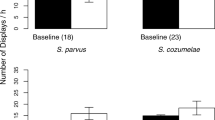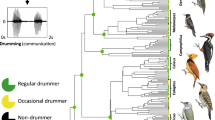Abstract
Long-term signal evolution is shaped by a variety of selective pressures including the need to convey additional information or to improve message transfer to specific receivers or through multiple environments. Here, we test the relative importance of information and sensory modality in shaping the long-term evolution of multimodal signals in Sceloporus lizards. To broadcast identity at territorial boundaries, male Sceloporus use both visual motion (headbob) and chemical signals, whereas they use color (blue belly patches) to signal aggression. Using modern phylogenetic comparative methods, we found a negative correlation between evolutionary changes in visual motion (headbobs) and chemical (femoral pore) signals, but only indirect ties between the evolution of color and motion signals (both of which are perceived visually) through viviparity, and no evidence of an evolutionary link between color and chemical signals. We also find a negative correlation between arboreality and chemical signals. Thus, information content (in this case, broadcasting individual identity versus signaling aggression) appears to play a more important role than sensory modality or physical distance in guiding long-term signal evolution. Additional insights into the underlying evolutionary processes are described, illustrating the utility of a phylogenetic approach.





Similar content being viewed by others
References
Alberts AC (1993) Chemical and behavioral studies of femoral gland secretions in Iguanid lizards. Brain Behav Evolut 41:255–260
Bro-Jørgensen J (2010) Dynamics of multiple signalling systems: animal communication in a world in flux. Trends Ecol Evol 25:292–300
Carpenter CC (1978) Comparative display behavior in the genus Sceloporus (Iguanidae). Contr Biol Geol Milw Publ Mus 18:1–71
Clark D, Roberts J, Rector M, Uetz GW (2011) Spectral reflectance and communication in the wolf spider, Schizocosa ocreata (Hentz): simultaneous crypsis and background contrast in visual signals. Behav Ecol Sociobiol 65:1237–1247
Cooper JWE (1987) Social significance of ventrolateral coloration in the fence lizard, Sceloporus undulatus. Anim Behav 35:526–532
Elias DO, Maddison WP, Peckmezian C, Girard MB, Mason AC (2012) Orchestrating the score: complex multimodal courtship in the Habronattus coecatus group of Habronattus jumping spiders (Araneae: Salticidae). Biol J Linn Soc 105:522–547
Felsenstein J (1985) Phylogenies and the comparative method. Am Nat 125:1–15
Felsenstein J (2012) A comparative method for both discrete and continuous characters using the threshold model. Am Nat 179:145–156
Gibson JS, Uetz GW (2008) Seismic communication and mate choice in wolf spiders: components of male seismic signals and mating success. Anim Behav 75:1253–1262
Gordon SD, Uetz GW (2011) Multimodal communication of wolf spiders on different substrates: evidence for behavioural plasticity. Anim Behav 81:367–375
Grether GF, Kolluru GR, Nersissian K (2004) Individual colour patches as multicomponent signals. Biol Rev 79:583–610
Guillette LJ Jr, Jones RE, Fitzgerald KT, Smith HM (1980) Evolution of viviparity in the lizard genus Sceloporus. Herpetologica 36:201–215
Hansen TF (1997) Stabilizing selection and the comparative analysis of adaptation. Evolution 51:1341–1351
Hansen TF, Pienaar J, Orzack SH (2008) A comparative method for studying adaptation to a randomly evolving environment. Evolution 62:1965–1977
Hews DK, Benard MF (2001) Negative association between conspicuous visual display and chemosensory behavior in two Phrynosomatid lizards. Ethology 107:839–850
Hews DK, Date P, Hara E, Castellano MJ (2011) Field presentation of male secretions alters social display in Sceloporus virgatus but not S. undulatus lizards. Behav Ecol Sociobiol 65:1403–1410
Hews DK, Moore MC (1995) Influence of androgens on differentiation of secondary sex characters in tree lizards, Urosaurus ornatus. Gen Comp Endocrinol 97:86–102
Hews DK, Quinn VS (2003) Endocrinology of species differences in sexually dimorphic signals and aggression: using the organization and activation model in a phylogenetic framework. In: Fox SF, Baird T, McCoy J (eds) Lizard social behavior. Johns Hopkins University Press, Baltimore, pp 253–277
Housworth EA, Martins EP, Lynch M (2004) The phylogenetic mixed model. Am Nat 163:84–96
Jacob S, Rieucau G, Heeb P (2011) Multimodal begging signals reflect independent indices of nestling condition in European starlings. Behav Ecol 22:1249–1255
Johnson MA, Wade J (2010) Behavioural display systems across nine Anolis lizard species: sexual dimorphisms in structure and function. Proc R Soc Lond B 277:1711–1719
Kaczorowski RL, Leonard AS, Dornhaus A, Papaj DR (2012) Floral signal complexity as a possible adaptation to environmental variability: a test using nectar-foraging bumblebees, Bombus impatiens. Anim Behav 83:905–913
Kohler G, Heimws P (2002) Stachelleguane. Lebensweise, Pflege, Zucht. Herpeton Verlag, Offenbach
Leaché AD (2010) Species trees for spiny lizards (genus Sceloporus): identifying points of concordance and conflict between nuclear and mitochondrial data. Mol Phylogenet Evol 54:162–171
Lynch M (1991) Methods for the analysis of comparative data in evolutionary biology. Evolution 45:1065–1080
Martins EP (1991) Individual and sex differences in the use of the push-up display by the sagebrush lizard, Sceloporus graciosus. Anim Behav 41:403–416
Martins EP (1993a) A comparative study of the evolution of Sceloporus push-up displays. Am Nat 142:994–1018
Martins EP (1993b) Contextual use of the push-up display by the sagebrush lizard, Sceloporus graciosus. Anim Behav 45:25–36
Martins EP (1996) Conducting phylogenetic comparative studies when the phylogeny is not known. Evolution 50:12–22
Martins EP (2004) COMPARE, version 4.6b. Computer programs for the statistical analysis of comparative data. Distributed by the author at http://compare.bio.indiana.edu/. Department of Biology, Indiana University, Bloomington.
Martins EP, Diniz-Filho JAF, Housworth EA (2002) Adaptive constraints and the phylogenetic comparative method: a computer simulation test. Evolution 56:1–13
Martins EP, Garland T Jr (1991) Phylogenetic analyses of the correlated evolution of continuous characters: a simulation study. Evolution 45:534–557
Martins EP, Hansen TF (1997) Phylogenies and the comparative method: a general approach to incorporating phylogenetic information into the analysis of interspecific data. Am Nat 149:646–667
Martins EP, Ord TJ, Davenport S (2005) Combining motions into complex displays: playbacks with a robotic lizard. Behav Ecol Sociobiol 58:351–360
Martins EP, Ord TJ, Slaven J, Wright J, Housworth E (2006) Individual, sexual, seasonal, and temporal variation in the amount of sagebrush lizard scent marks. J Chem Ecol 32:881–893
O’Meara BC, Ané C, Sanderson MJ, Wainwright PC (2006) Testing for different rates of continuous trait evolution using likelihood. Evolution 60:922–933
O’Loghlen AL, Rothstein SI (2010) Multimodal signalling in a songbird: male audiovisual displays vary significantly by social context in brown-headed cowbirds. Anim Behav 79:1285–1292
Ord TJ, Charles GK, Hofer RK (2011) The evolution of alternative adaptive strategies for effective communication in noisy environments. Am Nat 177:54–64
Ord TJ, Stamps JA, Losos JB (2010) Adaptation and plasticity of animal communication in fluctuating environments. Evolution 64:3134–3148
Pagel M (1994) Detecting correlated evolution on phylogenies: a general method for the comparative analysis of discrete characters. Proc R Soc Lond B 255:37–45
Pagel M, Meade A (2006) Bayesian analysis of correlated evolution of discrete characters by reversible–jump Markov chain Monte Carlo. Am Nat 167:808–825
Pagel M, Meade A (2011) BayesTraits v1.0. School of Biological Sciences, University of Reading, Reading, UK. Available at: www.evolution.rdg.ac.uk.
Painter D, Jennings DH, Moore MC (2002) Placental buffering of maternal steroid hormone effects on fetal and yolk hormone levels: a comparative study of a viviparous lizard, Sceloporus jarrovi, and an oviparous lizard, Sceloporus graciosus. Gen Comp Endocrinol 127:105–116
Partan SR, Marler P (2005) Issues in the classification of multimodal communication signals. Am Nat 166:231–245
Price JJ, Clapp MK, Omland KE (2011) Where have all the trees gone? The declining use of phylogenies in animal behaviour journals. Anim Behav 81:667–670
Quinn VS, Hews DK (2000) Signals and behavioural responses are not coupled in males: aggression affected by replacement of an evolutionarily lost colour signal. Proc R Soc Lond B 267:755–758
Quinn VS, Hews DK (2003) Positive relationship between abdominal coloration and dermal melanin density in Phrynosomatid lizards. Copeia 2003:858–864
Quinn VS, Hews DK (2010) The evolutionary decoupling of behavioral and color cues in a multicomponent signal in two Sceloporus lizards. Ethology 116:509–516
Ratcliffe JM, Nydam ML (2008) Multimodal warning signals for a multiple predator world. Nature 455:96–99
Rendall D, Owren MJ, Ryan MJ (2009) What do animal signals mean? Anim Behav 78:233–240
Ronquist F (2004) Bayesian inference of character evolution. Trends Ecol Evol 19:475–481
Sadeghi S, Mitchell D, Cullen K (2009) Different neural strategies for multimodal integration: comparison of two macaque monkey species. Exp Brain Res 195:45–57
Sites JW, Reeder TW, Wiens JJ (2011) Phylogenetic insights on evolutionary novelties in lizards and snakes: sex, birth, bodies, niches, and venom. Annu Rev Ecol Evol S 42:227–244
Smith CL, Taylor A, Evans CS (2011) Tactical multimodal signalling in birds: facultative variation in signal modality reveals sensitivity to social costs. Anim Behav 82:521–527
Smith HM (1939) The Mexican and Central American lizards of the genus Sceloporus, vol 26. Field Museum of Natural History, Chicago
Stynoski J, Noble V (2012) To beg or to freeze: multimodal sensory integration directs behavior in a tadpole. Behav Ecol Sociobiol 66:191–199
Sullivan-Beckers L, Hebets EA (2011) Modality-specific experience with female feedback increases the efficacy of courtship signalling in male wolf spiders. Anim Behav 82:1051–1057
Thompson JT, Bissell AN, Martins EP (2008) Inhibitory interactions between multimodal behavioural responses may influence the evolution of complex signals. Anim Behav 76:113–121
Uetz GW, Clark D, Roberts J, Rector M (2011) Effect of visual background complexity and light level on the detection of visual signals of male Schizocosa ocreata wolf spiders by female conspecifics. Behav Ecol Sociobiol 65:753–761
Uetz GW, Roberts JA, Taylor PW (2009) Multimodal communication and mate choice in wolf spiders: female response to multimodal versus unimodal signals. Anim Behav 78:299–305
Webb RG (2009) Crevice spiny lizard. In: Jones LLC, Lovich RE (eds) Lizards of the American Southwest: a photographic field guide. Rio Nuevo, Tucson, pp 246–249
Wiens JJ (1999) Phylogenetic evidence for multiple losses of a sexually selected character in phrynosomatid lizards. Proc R Soc Lond B 266:1529–1535
Wiens JJ, Kuczynski CA, Arif S, Reeder TW (2010) Phylogenetic relationships of phrynosomatid lizards based on nuclear and mitochondrial data, and a revised phylogeny for Sceloporus. Mol Phylogenet Evol 54:150–161
Wilgers DJ, Hebets EA (2012) Seismic signaling is crucial for female mate choice in a multimodal signaling wolf spider. Ethology 118:387–397
Acknowledgments
We thank Eileen Hebets and two anonymous reviewers for comments on this manuscript. This material is based upon the work supported by the National Science Foundation under grant numbers IOS-1050274 to EPM and IOS-1052247 to DKH. JAF was supported by a fellowship from Colciencias.
Author information
Authors and Affiliations
Corresponding author
Additional information
Communicated by E. A. Hebets
Rights and permissions
About this article
Cite this article
Ossip-Klein, A.G., Fuentes, J.A., Hews, D.K. et al. Information content is more important than sensory system or physical distance in guiding the long-term evolutionary relationships between signaling modalities in Sceloporus lizards. Behav Ecol Sociobiol 67, 1513–1522 (2013). https://doi.org/10.1007/s00265-013-1535-4
Received:
Revised:
Accepted:
Published:
Issue Date:
DOI: https://doi.org/10.1007/s00265-013-1535-4




